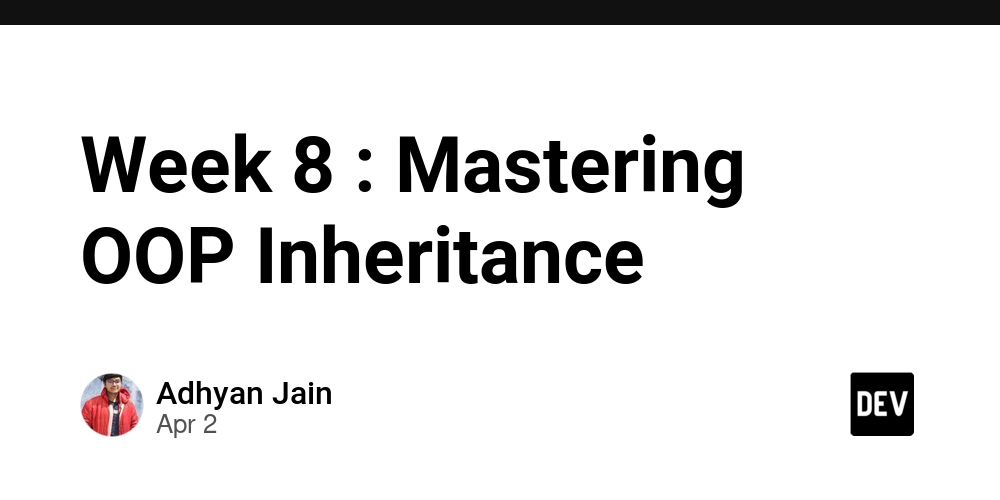Week 8 : Mastering OOP Inheritance
As part of my #100DaysOfCode challenge, I dedicated Days 50-56 to mastering inheritance in object-oriented programming. Here's a summary of my journey through different inheritance patterns and what I learned along the way. Day 50: Basic Inheritance I started with the fundamental parent-child class relationship: • Electronics Store: Created a Device base class with Television & Refrigerator subclasses • Sales Assistant: Implemented inheritance for displaying product details & calculating metrics • Product Cost Calculator: Used hierarchical inheritance for electronic & mechanical device pricing These projects demonstrated how inheritance promotes code reuse and specialization while maintaining a clear hierarchy. Day 51: Multiple Inheritance Multiple inheritance allows a class to inherit from more than one base class: • Loan Calculator: Designed Principal & InterestRate classes with Loan inheriting from both • Ticket Booking System: Built a system handling both concert & movie tickets • Academic Performance Tracker: Created a Student class inheriting from GPA & CreditHours classes The challenge here was understanding potential ambiguity issues when classes inherit from multiple sources. Day 52: Multi-level Inheritance Next, I explored multi-level inheritance, which creates chains of inheritance: • Financial Calculator: Built Investment → FixedDeposit → SimpleInterest inheritance chain • Order Cost Calculator: Implemented Order → FinalOrder → DiscountedOrder structure • Social Media System: Designed User → Blogger → Influencer class hierarchy This pattern helped me understand how behavior accumulates through inheritance levels. Day 53: Protected Members Day 53 focused on access modifiers, particularly protected members: • Cylinder Volume Calculator: Created Circle base class with protected radius • Electrical Power Calculator: Implemented base class P with voltage & current attributes • Vehicle Rental System: Built Vehicle base class with Car & Motorcycle subclasses These projects demonstrated how protected members strike a balance between encapsulation and inheritance. Day 54: Hybrid Inheritance Hybrid inheritance combines multiple inheritance types: • Dual Role Manager: Created a TeachingAssistant class inheriting from both Student & Employee • Multi-operation Calculator: Built child classes with inherited operations • Online Store System: Implemented hybrid inheritance for electronics & clothing products This complex pattern taught me how to model sophisticated real-world relationships. Day 55: Constructor Overloading While not strictly an inheritance concept, constructor overloading pairs naturally with inheritance: • Goods Cost Calculator: Implemented default & parameterized constructors • Simple Interest Calculator: Created multiple constructors for different initialization scenarios • Forest Rainfall Calculator: Used constructor overloading for square & rectangular areas This reinforced how constructors work across inheritance hierarchies. Day 56: Function Overloading I concluded with function overloading: • Minimum Value Finder: Created overloaded functions for different data types • Unit Converter: Implemented overloaded conversion functions • Shopping Cart: Designed overloaded price calculation functions for various scenarios This exercise demonstrated how polymorphism complements inheritance to create flexible interfaces. Key Takeaways After a week of intensive practice, I gained several valuable insights: Inheritance is powerful but requires planning - Poor hierarchies lead to rigid code Access modifiers matter - Protected members are crucial for proper inheritance Real-world modeling - The best inheritance hierarchies mirror natural relationships Has anyone else tackled similar inheritance challenges? Which inheritance pattern do you find most useful in production code?

As part of my #100DaysOfCode challenge, I dedicated Days 50-56 to mastering inheritance in object-oriented programming. Here's a summary of my journey through different inheritance patterns and what I learned along the way.
Day 50: Basic Inheritance
I started with the fundamental parent-child class relationship:
• Electronics Store: Created a Device base class with Television & Refrigerator subclasses
• Sales Assistant: Implemented inheritance for displaying product details & calculating metrics
• Product Cost Calculator: Used hierarchical inheritance for electronic & mechanical device pricing
These projects demonstrated how inheritance promotes code reuse and specialization while maintaining a clear hierarchy.
Day 51: Multiple Inheritance
Multiple inheritance allows a class to inherit from more than one base class:
• Loan Calculator: Designed Principal & InterestRate classes with Loan inheriting from both
• Ticket Booking System: Built a system handling both concert & movie tickets
• Academic Performance Tracker: Created a Student class inheriting from GPA & CreditHours classes
The challenge here was understanding potential ambiguity issues when classes inherit from multiple sources.
Day 52: Multi-level Inheritance
Next, I explored multi-level inheritance, which creates chains of inheritance:
• Financial Calculator: Built Investment → FixedDeposit → SimpleInterest inheritance chain
• Order Cost Calculator: Implemented Order → FinalOrder → DiscountedOrder structure
• Social Media System: Designed User → Blogger → Influencer class hierarchy
This pattern helped me understand how behavior accumulates through inheritance levels.
Day 53: Protected Members
Day 53 focused on access modifiers, particularly protected members:
• Cylinder Volume Calculator: Created Circle base class with protected radius
• Electrical Power Calculator: Implemented base class P with voltage & current attributes
• Vehicle Rental System: Built Vehicle base class with Car & Motorcycle subclasses
These projects demonstrated how protected members strike a balance between encapsulation and inheritance.
Day 54: Hybrid Inheritance
Hybrid inheritance combines multiple inheritance types:
• Dual Role Manager: Created a TeachingAssistant class inheriting from both Student & Employee
• Multi-operation Calculator: Built child classes with inherited operations
• Online Store System: Implemented hybrid inheritance for electronics & clothing products
This complex pattern taught me how to model sophisticated real-world relationships.
Day 55: Constructor Overloading
While not strictly an inheritance concept, constructor overloading pairs naturally with inheritance:
• Goods Cost Calculator: Implemented default & parameterized constructors
• Simple Interest Calculator: Created multiple constructors for different initialization scenarios
• Forest Rainfall Calculator: Used constructor overloading for square & rectangular areas
This reinforced how constructors work across inheritance hierarchies.
Day 56: Function Overloading
I concluded with function overloading:
• Minimum Value Finder: Created overloaded functions for different data types
• Unit Converter: Implemented overloaded conversion functions
• Shopping Cart: Designed overloaded price calculation functions for various scenarios
This exercise demonstrated how polymorphism complements inheritance to create flexible interfaces.
Key Takeaways
After a week of intensive practice, I gained several valuable insights:
- Inheritance is powerful but requires planning - Poor hierarchies lead to rigid code
- Access modifiers matter - Protected members are crucial for proper inheritance
- Real-world modeling - The best inheritance hierarchies mirror natural relationships
Has anyone else tackled similar inheritance challenges? Which inheritance pattern do you find most useful in production code?






















































.jpg)
%20Abstract%20Background%20112024%20SOURCE%20Amazon.jpg)



















































































































![[The AI Show Episode 142]: ChatGPT’s New Image Generator, Studio Ghibli Craze and Backlash, Gemini 2.5, OpenAI Academy, 4o Updates, Vibe Marketing & xAI Acquires X](https://www.marketingaiinstitute.com/hubfs/ep%20142%20cover.png)
































































































































![From drop-out to software architect with Jason Lengstorf [Podcast #167]](https://cdn.hashnode.com/res/hashnode/image/upload/v1743796461357/f3d19cd7-e6f5-4d7c-8bfc-eb974bc8da68.png?#)





































































































.png?#)





.jpg?#)
































_Christophe_Coat_Alamy.jpg?#)











































































































![Rapidus in Talks With Apple as It Accelerates Toward 2nm Chip Production [Report]](https://www.iclarified.com/images/news/96937/96937/96937-640.jpg)









































































































































